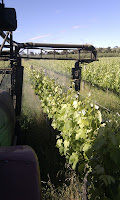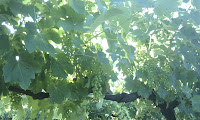Right now, chemical suppliers can hardly keep up with demand for fungicides to control what is said to be the largest downy mildew outbreak Australia has seen for 2 decades. According to ABC Radio, Riverland branch of chemical producer, Landmark, says it has sold up to 10 times the amount of downy mildew chemicals it usually would at this time of year. Good news for them, but not good news for wine drinkers.
 Downy mildew is a fungus that can spread rapidly in vineyards in the wet weather we have had recently. Primary infection is said to occur through rainsplash from the ground, though this is hard to see happening when the ground is densely covered with grass and weeds, as is the case here. The oily spots that develop on the odd vine then spread with subsequent rain and can kill the grape flowers. I took this photo in a neighbouring vineyard a few days ago, and you can see the slimy brown remains of the bunch flowers. In the worst case, ALL the flowers die and you get no fruit. The good news is that once the berries have developed from the flowers they are much more resistant, and it doesnt affect quality at harvest, like other diseases (powdery mildew and botrytis) This photo was taken after the 100mm we received last Thursday 9 December 2010.
Downy mildew is a fungus that can spread rapidly in vineyards in the wet weather we have had recently. Primary infection is said to occur through rainsplash from the ground, though this is hard to see happening when the ground is densely covered with grass and weeds, as is the case here. The oily spots that develop on the odd vine then spread with subsequent rain and can kill the grape flowers. I took this photo in a neighbouring vineyard a few days ago, and you can see the slimy brown remains of the bunch flowers. In the worst case, ALL the flowers die and you get no fruit. The good news is that once the berries have developed from the flowers they are much more resistant, and it doesnt affect quality at harvest, like other diseases (powdery mildew and botrytis) This photo was taken after the 100mm we received last Thursday 9 December 2010.
 We cannot claim to have no mildew at Rosnay now, and would say that any grower claiming not to have some probably hasnt looked hard enough. When we first saw oil spots in our Shiraz we incubated them in a plastic bag overnight with some wet tissue paper in it, and the classic “down” of fluffy white fungus grew overnight. Since then we have been spraying copper and sulfur (both organically approved) every 2 weeks or so, or about 3 times in total. We avoid spraying with the tractor (as in this photo) unless the ground is firm and dry, to avoid pugging and compacting it. However, we have also been spraying with biodynamic silica and equisetum (horsetail) tea with the Suzuki ute which is relatively lightweight and fast (doing 4-5 rows at a time), meaning we can do it when the ground is a bit wet. Silica helps make the vines tissue more tough and turgid.
We cannot claim to have no mildew at Rosnay now, and would say that any grower claiming not to have some probably hasnt looked hard enough. When we first saw oil spots in our Shiraz we incubated them in a plastic bag overnight with some wet tissue paper in it, and the classic “down” of fluffy white fungus grew overnight. Since then we have been spraying copper and sulfur (both organically approved) every 2 weeks or so, or about 3 times in total. We avoid spraying with the tractor (as in this photo) unless the ground is firm and dry, to avoid pugging and compacting it. However, we have also been spraying with biodynamic silica and equisetum (horsetail) tea with the Suzuki ute which is relatively lightweight and fast (doing 4-5 rows at a time), meaning we can do it when the ground is a bit wet. Silica helps make the vines tissue more tough and turgid.
 After looking at the neighbours place I raced to see if it was the same at Rosnay, and looked in the Shiraz, where we have historically had the most downy. To my amazement, I have actually found very little bunch infection, but of course plenty of leaf infection. The vines seemed to be standing up much better, and the canopy, being hand pruned, is much more open to air and light. As you can see from this photo, there is not much mildew, and the grapes are uninfected. Our view, as expained elwhere in this blog, is that organic farming makes the vines tougher and more resistant, whilst systemic chemicals (ie metalaxyl and phosphoric acid) create weakness in the vines tissues, especially for late season infection with botryis. Systemics also suffer from problems of resistance and residues in the finished wine.
After looking at the neighbours place I raced to see if it was the same at Rosnay, and looked in the Shiraz, where we have historically had the most downy. To my amazement, I have actually found very little bunch infection, but of course plenty of leaf infection. The vines seemed to be standing up much better, and the canopy, being hand pruned, is much more open to air and light. As you can see from this photo, there is not much mildew, and the grapes are uninfected. Our view, as expained elwhere in this blog, is that organic farming makes the vines tougher and more resistant, whilst systemic chemicals (ie metalaxyl and phosphoric acid) create weakness in the vines tissues, especially for late season infection with botryis. Systemics also suffer from problems of resistance and residues in the finished wine.
The big test will happen when it warms up, and if we get a heat wave some bunches that appear to be fine may not actually be fine. If it dries out enough, the next organic weapon to try will be compost tea, which we have tried int he past without success, but which is said to work against downy. We are in uncharted waters, and will keep you posted. If you have any questions or suggestions feel free to comment!
I found that old Town and Country Farmer 2004 article on BD viticulture by Cheryl Kemp. So much to do! http://www.biodynamics.net.au/articles/T&C%20Viticulture%20PDF.pdf
Thanks John. We do have a lot to learn still, and organic growers all have different situations and techniques. Sometimes its just really hard to tell if something works or not. This year we too used a herbal fungicide, an equisetum (horsetail) tea, and maybe its one reason the vines are still holding up. Whilst I am sure that herbal teas increase the vines’ resistance in the long term, I also think in some seasons you need something that is reliable at controlling the sporulation events (aplenty this year) that lead to the point of no return (and bad wine). So we use good old bordeaux as well this season (for the first time in many years, though).
There are several products that they say can control downy mildew, such as compost teas and tree pastes, which we have tried now and again and should be doing more with. Chamomile tea too – though according to Jackie French its only a “mild” fungicide helpful for “damping off” of seedlings. Seaweed seems to be good too.
We also sprayed milk on the chardonnay a couple of weeks ago, as soon as we saw some powdery mildew on some berries. It had less effect than sulfur on bunches. With our standard spray equipment its mostly effective on the leaves, but not the bunches where powdery mildew is the main problem. I’ll have to do a separate post on powdery mildew, which is a completely different beast in all except the name “mildew”, and is usually a bigger problem.
Hi Sam,
I’m sorry this is happening.
I wish you all the luck you can use on this one!
I also hope the downpour this weekend hasn’t caused to much damage either. I heard the Belubula River was at a dangerous level now.
Bram